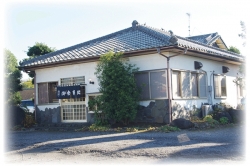表示形式
表示切替
開催月で表示
- 2025年02月
- 2025年03月
- 2025年04月
- 2025年05月
- 2025年06月
- 2025年07月
- 2025年08月
- 2025年09月
- 2025年10月
- 2025年11月
- 2025年12月
- 2026年01月
- 2026年02月
カテゴリ別に表示
戻る
2024年11月25日~2025年1月25日 / 千葉県 佐倉市 / その他

| 会場 | 国立歴史民俗博物館 総合展示 第3室 特集展示室 |
|---|---|
| 住所 | 285-8502 千葉県 佐倉市 城内町117 |
| 日程 | 2024年11月25日~2025年1月25日 |
| 時間 | 9時30分~16時30分 |
- [時間詳細]
・9:30~16:30(入館は16:00まで)
・休館日:月曜日(月曜日が休日の場合は開館し、翌日休館)、12月10日(火)、1月7日(火)、年末年始(12月27日(金)~1月4日(土))
- [アクセス]
【電車の場合】
・京成電鉄「京成佐倉駅」から徒歩約15分 または バス約5分
・JR東日本「佐倉駅」からバス約15分
【車の場合】
・東関東自動車道 四街道ICまたは佐倉ICより約15分、国道296号沿い(無料駐車場完備)
- [会場詳細]
国立歴史民俗博物館 総合展示 第3室 特集展示室
千葉県佐倉市城内町117
第3展示室 特集展示 「歴史・文化の中の鄭成功」
- [お問い合わせ先]
- 050-5541-8600(ハローダイヤル)
- [登録者]国立歴史民俗博物館
- [言語]日本語
- [TEL]050-5541-8600
- 登録日 : 2024/11/06
- 掲載日 : 2024/11/06
- 変更日 : 2024/11/06
- 総閲覧数 : 162 人
- お店を検索するなら『タウンガイド』
-
- 本格中華がリーズナブルに食べられます。日替わり定食は、「ごはん、味噌汁、焼肉、冷...

-
店内はカウンター、テーブル席、お座敷があり、小さなお子様連れのご家族から団体様まで幅広くご利用いただけます。日替わり定食は、「ごはん、味噌汁、焼肉、冷や奴」や「ラーメン、餃子」などのさまざまな組み合せで、毎日(土日も)600円で販売しております。ボリュームがあるものを食べたい人には是非どうぞ♪5名様〜50名さままで、宴会うけたまわります。
+81-438-98-1033食堂月村
-
- アメリカの会計事務所です。法人、個人を問わず、タックスリターン(確定申告)、アメ...

-
日米間の税務サポート!迅速な手続きとアフターケア!日本語・英語どちらにも対応しております。
+1 (877) 827-1040Todd's Accounting Services / Mayumi Ozaki (尾崎会計事務所)
-
- カウンセリングテスト+説明会を開催します!

-
海外帰国生入試の合格実績で定評のある「早稲田アカデミー」が、ロサンゼルスに開校致します。対面授業はもちろんのことZoomを使用したリアルタイムのオンライン授業も配信するため、アメリカのみならずカナダ、メキシコにお住まいの海外生も時差を気にせず受講いただけます。また、日本の早稲田アカデミーならではの最新の受験情報もご提供してまいります。「自分の夢をかなえるために、本気で勉強するぞ!」という方は、ぜひ...
+1 (424) 263-2544早稲田アカデミー ロサンゼルス校
-
- コンドミニアムから一戸建て、商業物件の売買/物件管理まで幅広くご案内いたします。...

-
東京都出身。ミシガン州立大学医療心理学科卒業。日本にて三井物産本社勤務の後、米国にてゼネラルモーターズ、日産デザイン、日本航空での勤務を経て、不動産取引免許、不動産ブローカー免許を取得。ハワイを含めて米国に30年以上在住。不動産取引がスムーズに行われるために、最高のサービスをご提供できるよう日々尽力しています。
+1 (808) 591-2002モアナリアルティー
-
- 日米協会(JASG)は、501(c)(3)の非営利団体で、文化、習慣、教育、商業...

-
ジョージア日米協会は、日本人にとってジョージア州が、北アメリカで最も住みやすく、訪問しやすい場所となるよう、また、ジョージア州が北アメリカの中で、最も国際色豊かな州になるよう、活動を続けています。日米協会(JASG)は、日本とジョージア州の文化交流および相互理解の促進を使命とする501(c)(3)の非営利団体です。各国際機関や各種組織などと協力し、ジョージア州に於いて、国際文化や国際ビジネスへの理...
+1 (404) 842-1400JASG ジョージア日米協会
-
- 鴨川市横渚にある本格イタリアンCaSa。家のようなくつろぎと安心できる食材、そし...

-
都内の人気レストランで修行経験のある本格シェフによるイタリアンを鴨川でお楽しみいただけます。店内はーチ型のカウンター席や庭園を望むフロアー席、幻想的な地下個室で、おうちのような心安らぐひとときをお過ごしいただけます。ピッツァ、パスタ、単品料理、カフェ、ノンアルコールドリンク、美味しいワインまで豊富なメニューをご用意し、皆さまをお待ちしております。ここでしか味わえない、香り、味、ぜひ一度ご賞味下さい...
+81-4-7093-0358CaSa
-
- 千葉県木更津を中心にお庭などお家周りのリフォームします。50年の施工実績があり綺...

-
創業50年現在3代目になります。 斉藤ではお客様のご要望を第一に考えお客様の満足の行くようなプランをご提案させて頂きます。 お気軽にご相談ください。・お見積り無料・ 小さい工事から大きい工事その他色々なご相談に乗ります。 皆様のご依頼を心よりお待ちしております!エクステリア・新規外構工事・お庭のリフォーム・外構工事または内装タイル工事・内装左官工事・フェンス・ウッドデッキ・ガレージ・物置・人工芝・...
+81-90-6113-5078株式会社斉藤
-
- ♪音楽未経験の完全初心者から歓迎♪ 「歌が上手くなりたい」「好きな曲をピアノで...

-
♪音楽未経験の完全初心者から歓迎♪ 「歌が上手くなりたい」「好きな曲をピアノで弾きたい」「ギターが弾けるようになりたい」「コードを読みながら自由に弾きたい」「作曲をしてみたい」「弾き語りをしたい」「試験等の対策に音楽の理論を学びたい」などの一人ひとりの目標に沿った完全オーダーメイドレッスンです。
+81-3-5244-5221アーティファクト ミュージックスクール 木更津ルーム
-
- ✅WEB,SNS,ネット広告,アプリ開発,システム開発,デジタルマーケティング,...

-
WEB開発,SNS支援,SNS代行,ネット広告支援,アプリ開発,システム開発,デジタルマーケティング等の対応させて頂いております。・Web・アプリ構築・運営・ソーシャルメディア構築・運営・デジタルマーケティング(SEO,SEM,アフェリエイト)・オンライントラブル対応・サーバー・ネットワーク設定・業種業態別のITソリューション提案・経費削減ITコンサルなど弊社では企業様のオンライン化をキーワードに...
+1 (619) 794-0122アイティーワークス
-
- Salon LANI
-
- そうだ〜!ビーチクリーンに行こう!!!ホノルル海さくらは毎月1回ビーチの清掃をし...

-
ホノルル海さくらは毎月1回ビーチクリーンをしていきます!ビーチクリーンの後は楽しい BBQがあります (ない時もあります)。いろいろな人たちと交流できるので、ハワイライフがもっと楽しくなると思います。Honolulu Umisakura will be hosting one beach cleanup event every month!After the beach cleanup, we w...
ホノルル海さくら / Honolulu Umisakura
-
- San Joseの昔ながらの本格居酒屋です。メニューが豊富で日本人オーナーの握る...

-
メニューが豊富、お寿司も美味しい《IZAKA-YA》と言う名の居酒屋です。ベイエリアでは珍しく夜11時まで営業しております。おいしい日本食が食べたくなったら、日本の居酒屋の雰囲気が恋しくなったら、お気軽にお越しください。スタッフ一同お待ち申し上げております!
+1 (408) 452-8751Izaka-ya
-
- アラモアナにあるバイリンガルのクリニック「体外衝撃波治療、顎関節症、その他身体の...

-
痛みの回復のスペシャリストとして、凝りからくる頭痛、首の痛み、肩の痛み、腰の痛み、その他の身体の痛みを、筋肉、関節、神経など痛みの原因となる部分を、カイロプラクティック、アスレチックトレーニング、指圧、整体、リハビリなどを用いて回復を手助けし痛みを改善しています。痛みのない生活へ!頭痛、偏頭痛、首の痛み、肩こり、腰の痛み、座骨神経痛、スポーツでの怪我その他生活に支障を及ぼしている怪我痛みに悩まさせ...
+1 (808) 465-4700トリオ・カイロプラクティック | TRIO Chiropractic
-
- JCCCNC strives to meet the evolving need...

-
JCCCNC strives to meet the evolving needs of the Japanese American community through offering programs, affordable services and facility usage.
+1 (415) 567-5505Japanese Cultural and Community Center of Northern California
-
- 木更津市清川にある『輝耕電設』では、照明の取り付けはもちろんコンセントの増設、エ...

-
照明リフォーム、エアコン、コンセント増設、アンテナ設置など、お気軽にお問い合わせください。☑ お部屋をお洒落に一新したい。 ☑ 室内を明るくし気分転換したい。 ☑ 店舗やオフィスの雰囲気やイメージを変えたい。 ☑ 照明で空間に奥行きをプラスしたい。 ☑ 駐車場に照明を設置したい。 ☑ コンセントを増設したい。 ☑ エ...
+81-80-5372-1000株式会社 輝耕電設








日本では、鄭成功の死後50余年を経て、鄭成功をモデルにした人形浄瑠璃『国性爺合戦』が近松門左衛門によって生み出されました。長期公演となる人気を博し、歌舞伎化されるなどして、そのイメージが流布していきました。和藤内(鄭成功)が虎と格闘する場面は、民俗芸能としても現代に伝えられています。また、台湾を植民地化(1895~1945年)した日本は、鄭成功の物語を台湾統治の正当性を示すために利用しました。
本特集展示では、鄭成功が生きた17世紀、日本で新たな物語へと変容する18世紀、そして近現代という3つの時代における、日本と台湾の鄭成功に対するイメージを通して、台湾と日本の歴史と文化のつながりを考えてみたいと思います。
なお本特集展示は、国立台湾歴史博物館との交流事業として同館との共催により開催するものです。
【料金】
一般600円、大学生250円、高校生以下無料
※総合展示もあわせてご覧になれます。
※障がい者手帳等保持者は手帳等提示により、介助者と共に入館無料です。
※高校生及び大学生の方は、学生証等を提示してください。
※博物館の半券の提示で、当日に限りくらしの植物苑にご入場できます。
また、植物苑の半券の提示で、当日に限り博物館の入館料が割引になります。
【主催】
大学共同利用機関法人 人間文化研究機構 国立歴史民俗博物館
国立台湾歴史博物館
【協力】
台南市立博物館